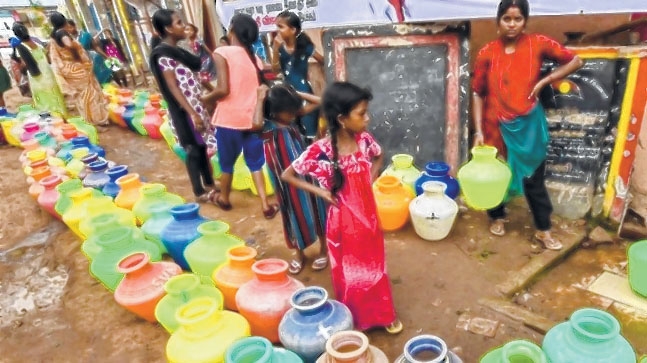How Chennai lost its water, a story that should worry you

-Prabhash K Dutta
Chennai has lost huge areas earlier covered by water bodies to development projects and illegal encroachments over decades.Chennai is practically the first Indian city to have gone dry with the Central Water Commission reporting a rainfall deficit of 41 per cent in Tamil Nadu till June 13 this year.
Most of Chennai's population today is dependent on water tankers and curtailed municipal supply for daily requirement of drinking water. News television screens show women waiting for hours in long queues and scurrying to water tankers to get water which barely meets the drinking and kitchen requirements. Water for sanitation is scarce. Laundry and bathing are nothing short of luxury in today's Chennai.
Price of Bottled water is reported to have gone up four times while packaged water can only be sustained by wealthier middle-class. IT sector companies have asked employees to work from home. Several restaurants have shut down operations. City is filled with 'don't waste water' bills, stickers and banners.
But how did Chennai lose its water?
Three rivers - the Cooum, the Adyar, and the Kosasthalaiyar - flow through Chennai into the Bay of Bengal. The Buckingham canal connects all the three rivers.
North Chennai gets its water from reservoirs in Thamaraipakkam and Minjur desalination plant. South Chennai gets its water from Veeranam lake and Nemmeli seawater desalination plant.
Chennai used to be water-surplus metropolitan cities of the country till a couple of decades ago. Following the age-old water conservation tradition of Tamil Nadu, Chennai had nearly two dozen water bodies including three rivers and a British period Buckingham canal. Today, it is reduced to half a dozen.
A study by the Anna University has found that Chennai has lost 33 per cent of its wetlands in the last one decade. During the same period, Chennai lost 24 per cent agricultural land, crucial for improving groundwater table.
The Centre for Climate Change that conducted the study blamed road construction - highways and flyovers, airports and high-rises for depleting water resources in Chennai. These development projects were undertaken on reclaimed water bodies are largely to blame.
All three rivers and the Buckingham Canal are dry today except for a few patches here and there. Same is the case with wetlands. Reports say that wetlands such as Pallikaranai Marsh, Pulicat Lake, Kattupalli Island, Madhavaram and Manali Jheels and the Adyar Estuary Creek have been encroached upon to expand urban settlements.
The Valluvar Kottam irony
The story of destruction began in 1970s. Ironically, Tamil Nadu's most famous poet, Thiruvalluvar today stands as a symbol of government's neglect of water needs of Chennai and the biggest warning of water crisis. The Tamil Nadu Water Supply and Drainage Board has an image of Thiruvalluvar to stress on the importance of water and its preservation.
The ancient age poet had said "the world is preserved by the existence of rain" in one of his famous songs. Incidentally, during 1970s, the Tamil Nadu government filled the Nungambakkam lake and built a monument - Valluvar Kottam - dedicated to Thiruvalluvar. It stands at what was the deepest point in the Nungambakkam lake in Chennai. This monument is the story of how Chennai lost its water and became thirsty.
The four main water reservoirs that supply drinking water to Chennai are currently at less than one per cent of storage level. With the met department predicting a weaker monsoon, water woes of Chennai is far from over.
Courtesy IndiaToday